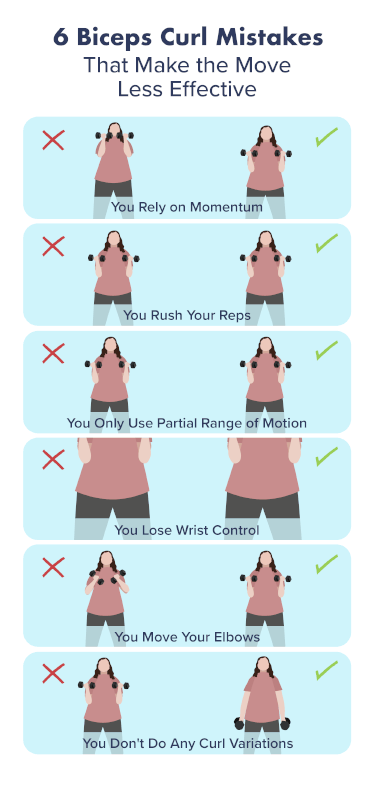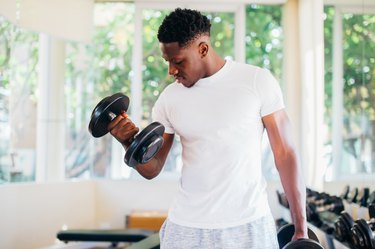

Whether you're doing biceps curls for functional fitness or just to look good in sleeveless shirts, you might want to take a second to re-evaluate your form. Because they seem so straightforward, they're commonly done incorrectly. And with so many variations, you might not even realize you're making a mistake.
While the specific variation or grip you do depends on your preferences and goals, there is a right and wrong way to perform this classic weight-lifting exercise. Consider these six common mistakes next time you train your biceps.
Video of the Day
Video of the Day
Proper Biceps Curl Form
First things first, let's establish the basics of good biceps curl form. Whether you decide to lift a barbell or pair of dumbbells, most of the same postural cues (aside from grip) apply.
- Hold the barbell with both hands facing up at about shoulder-width distance.
- Keeping your elbows glued to your sides and your chest upright, raise the barbell up toward your shoulders.
- At the top of the motion, focus on flexing your biceps.
- Slowly lower the barbell until your elbows extend fully at the bottom without locking.
6 of the Worst Biceps Curl Mistakes
Pretty simple, right? While biceps curls are fairly easy to understand and perform, the more reps you bust out, the easier it is to get lazy or forgetful with your form. Make sure you're not making any of the following errors, and if you are, take the time to address them.
1. Relying on Momentum
Using momentum in order to complete a biceps curl is among the most common mistakes, says Sam Becourtney, physical therapist at Bespoke Treatments in New York City. Fortunately, it's easy to spot, whether you're observing another gym-goer or looking in the mirror at yourself: At the top of the curl, the middle of the body swings slightly, the lower back overarches and the legs probably dip a little, Becourtney says.
Often, people begin to rely on the momentum when they select a weight that's too challenging. Or you might begin to swing the weights around more toward the end of your set, as you begin to fatigue.
Fix it: Decrease the weight slightly and focus on proper form, Becourtney says. Try to use only your elbow flexors to bring the weight up and down. Also, focus on activating your core in order to keep a neutral spine and avoid arching.
Using a mirror can give you a better look at your posture, giving you some visual feedback. Or, place a towel on the ground and perform the exercise on your knees (or sit down), which can limit your body's ability to sway or bounce.
2. Rushing Through Reps
Thanks to the effect of gravity, you may find yourself curling your weight up slowly, followed a much quicker lowering. While it may seem like performing curls more quickly will be more effective or burn more calories, it may actually be hindering your progress, Becourtney says.
In fact, the eccentric movement (lengthening of the muscle during the lowering portion of an exercise) generates more force production than concentric movement (shortening of the muscle when you raise the weight). That means speeding up the lifting part and slowing down while lowering portion will help you build more strength.
Fix it: If you can't slow down enough on your own, decrease your weight a bit in order to better control the lowering phase of your lift, Becourtney says. While you may be hesitant to go down in weight, rest assured you'll feel the exercise just as much (if not more) when you perform the move correctly at a lower weight than incorrectly at higher weight.
3. Performing Partial Range of Motion
Especially if you tend to "ego lift" more weight than you can sustain with proper form, you may be unintentionally performing curls with only partial range of motion. Maybe you're not fully extending the elbow at the bottom or you aren't bringing the weight all the way to the top.
Fix it: As long as you can perform the entire exercise pain-free, full range of motion should be the goal, Becourtney says. Choose a weight that you can curl with the full range of motion through your entire set and rep range. Just make sure you aren't hyperextending or locking out your elbows at the bottom.
4. Losing Wrist Control
While you should focus on contracting your biceps during your curls, don't neglect your wrists, either, says Becourtney. Often, people lose wrist control during the exercise, allowing the weight to control or collapse the wrist, especially during the lowering portion.
Fix it: Keep your wrist in a slightly flexed position that you're able to maintain throughout the movement, says Becourtney. Don't let your wrist flip into extension as you lower the weight, as this can increase risk of injury.
5. Moving Your Elbows
Often paired with using momentum during the exercise, you may notice your elbows flare out or move behind your back as you lift the weight, says Mathew Forzaglia, certified personal trainer and founder of Forzag Fitness on the NEOU App.
Fix it: Using a mirror, focus on keeping the elbows pinned to the sides of your body, keeping a straight back, too. If you struggle to keep your elbows at your sides, you may need to lower the weight you're using.
6. Not Doing Any Variations
Elbow flexion (bending the elbow) can only occur with the help of several muscles, including your biceps brachii, brachioradials and brachialis, Becourtney says. But performing only one version of a curl can sometimes lead to neglect of certain accessory muscles in this movement.
Fix it: Vary your grip on the weights in order to hit all of these muscles. In addition to the palms-up, standard grip, try neutral grip (hammer curls) and palms down (reverse curls). Also, opt for a variety of weights, too, including dumbbells, barbells and cable machines.
The Single Best Biceps Curl Variation
While it's important to train a variety of curls and grips, as Becourtney mentioned, one curl variation does stand out against the others. If gaining biceps strength and size is your goal, do concentration curls.
When compared to cable curls, barbell curls, chin-ups and EZ-bar curls, concentration curls — which are performed in a seated position with the curling elbow propped up on the inner portion of the knee — have shown significantly higher biceps activation than the others, according to August 2014 research from the American Council on Exercise (ACE).
Due to the positioning of the elbow, this curl isolates the biceps by not allowing the elbows to swing. However, researchers think there may be a mental aspect at play, too. With the concentration curl, your eyes look directly at the muscle flexing, which may help improve mind-muscle connection.
Here's how to do concentration curls, according to ACE:
- Begin seated on a chair or bench, holding a dumbbell in your right hand, resting between your legs.
- Place the back of your right upper arm against the inside of your right thigh.
- With the palm facing up, curl the weight to your shoulder.
- Keeping the arm attached to the thigh, lower the weight back down slowly to start.
- After you complete your repetitions, repeat on the other arm.